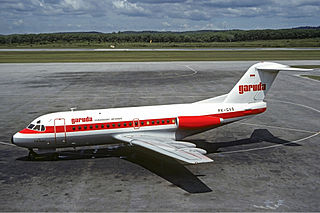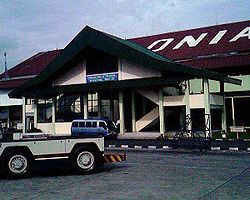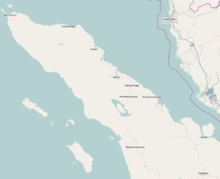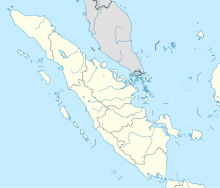
Medan is the capital and largest city of the Indonesian province of North Sumatra. The nearby Strait of Malacca, Port of Belawan, and Kualanamu International Airport make Medan a regional hub and multicultural metropolis, acting as a financial centre for Sumatra and a gateway to the western part of Indonesia. About 60% of the economy in North Sumatra is backed by trading, agriculture, and processing industries, including exports from its 4 million acres of palm oil plantations. The National Development Planning Agency listed Medan as one of the four main central cities in Indonesia, alongside Jakarta, Surabaya, and Makassar. In terms of population, it is the most populous city in Indonesia outside of the island of Java. Its population as of 2023 is approximately equal to the country of Moldova.

Soekarno–Hatta International Airport, abbreviated SHIA or Soetta, formerly legally called Jakarta Cengkareng Airport, is the primary airport serving the Jakarta metropolitan area on the island of Java in Indonesia. Named after the first president and vice-president of Indonesia, Sukarno (1901–1970) and Mohammad Hatta (1902–1980), the airport is located at Benda, Tangerang and Cengkareng, West Jakarta, which is about 20 km northwest of Central Jakarta. Together with Halim Perdanakusuma International Airport, they served over 80 million passengers in 2019.

Sultan Aji Muhammad Sulaiman Sepinggan International Airport, formerly named as Sepinggan Airport, is an international airport serving the city of Balikpapan and adjacent areas of East Kalimantan, located in Kalimantan, Indonesia. The airport began its new operational phase on 6 August 1997, with a new building and runway structure, replacing the old structure on the same site. The airport is operated by PT. Angkasa Pura I, which has an area of 300 hectares.

Adisutjipto Airport or Adisucipto Airport is a minor domestic airport serving the Yogyakarta area on the island of Java, Indonesia. It was formerly the principal international airport serving this area. The airport is located in the Sleman Regency, in the Yogyakarta Special Region, on the northeast outskirts of the city, near the Prambanan historic temple site. The airport is approximately 6 kilometres (3.7 mi) from the city centre.

Minangkabau International Airport is an airport serving the province of West Sumatra on the island of Sumatra, Indonesia. It is located at Ketaping, Padang Pariaman Regency which is about 23 km north-west of Padang city center. The airport became operational in July 2005, replacing the old Tabing Airport in Padang. The airport is named after the Minangkabau ethnic group who inhabit the region.

Kualanamu International Airport — often spelled as Kuala Namu and informally abbreviated KNIA — is an international airport serving Medan, Indonesia, and other parts of North Sumatra. It is located in the Deli Serdang Regency, 23 kilometres (14 mi) east of downtown Medan. Kualanamu is the third-largest airport in Indonesia after Jakarta Soekarno–Hatta and Bandung Kertajati, and the fifth busiest airport in Indonesia as of 2018, as well as the first Indonesian airport to receive a four-star rating from Skytrax.

Jenderal Ahmad Yani Airport is an airport serving the city of Semarang, in Central Java, Indonesia. The airport is named in honor of Ahmad Yani (1922–1965), who is a National Hero of Indonesia. As of 2018, it was one of the fastest-growing airports in the world by growth percentage. The airport is operated by PT Angkasa Pura I, a state enterprise of the Indonesian Ministry of Transportation that manages airports in the eastern part of the country.

Juanda International Airport is an international airport located in Sedati District, Sidoarjo Regency, East Java, Indonesia. It is now the third busiest airport in Indonesia. This airport is located approximately 12 kilometres from Downtown Surabaya and serves the Surabaya metropolitan area, the metropolitan area of Surabaya plus extended urban area. Juanda International Airport is operated by PT Angkasa Pura I. The airport takes its name after Djuanda Kartawidjaja (1911–1963), the last Prime Minister of Indonesia who had suggested development of this airport. In 2019, the airport served about 500 aircraft per day.

Sultan Syarif Kasim II International Airport, is an international airport serving the city of Pekanbaru, Riau, Indonesia. The airport is often referred to as SSK II, SSK or Sultan Syarif Qasim II International Airport, and was formerly known as Simpang Tiga Airport. The airport is named after Sultan Syarif Kasim II (1893–1968), the last sultan of Siak and an Indonesian National Hero. The airport serves flights to and from several cities and towns in Indonesia as well as international connections to Malaysia, Saudi Arabia, Singapore, Sri Lanka, and Thailand.

Garuda Indonesia Flight 152 (GA152/GIA152) was a scheduled domestic flight operated by Garuda Indonesia from Soekarno–Hatta International Airport, Tangerang, to Polonia International Airport, Medan, in Indonesia. On 26 September 1997, the aircraft flying the route crashed into mountainous woodlands near the village of Buah Nabar, Sibolangit, killing all 222 passengers and 12 crew members on board. It is the deadliest aviation disaster in Indonesia's history.

Sultan Iskandar Muda International Airport (IATA: BTJ, ICAO: WITT) also called Banda Aceh Airport (Bandar Udara Banda Aceh), is an airport located 13.5 km (1.35×1013 nm; 8.4 mi) southeast of the capital of Aceh province, Banda Aceh. It is named after the twelfth sultan of Aceh, Iskandar Muda (1583–1636). This airport was formerly called Blangbintang Airport (Bandara Blangbintang), referred to its location in a district with same name. This airport is listed as the 23rd busiest airport in Indonesia.

Sultan Mahmud Badaruddin II Airport is a domestic airport serving the city of Palembang, South Sumatra, Indonesia, and surrounding areas. It is located in the region KM.10 Talang Betutu District. It is named after Sultan Mahmud Badaruddin II (1767–1852), the last sultan of Palembang.

Sultan Thaha Syaifuddin Airport, formerly known as Palmerah Airport, is in Jambi City in the Jambi province of Indonesia. It is located in the Paalmerah suburb of Jambi. The airport is named after Thaha Syaifuddin, the last Sultan of Jambi (1816–1904).

Supadio Airport, formerly known as Sei Durian Airport or Sungai Durian Airport, is a domestic airport serving Pontianak, West Kalimantan, Indonesia. It is located 17 kilometres (11 mi) from Downtown Pontianak. The airport is managed by PT. Angkasa Pura II, and takes up 528 ha. The airport serves as the main point of entry to West Kalimantan. The airport serves domestic routes only as of mid-2023. The airport was named the best airport in Asia-Pacific in 2020 by Airports Council International.

Kemayoran Airport, also known in its old spelling as Kemajoran, was the principal airport in Jakarta, Indonesia from 1940 until 1985. Kemayoran was built during Dutch East Indies administration by the Department of Transport, Public Works and Irrigation in 1934 on the land that was formerly swamps, rice fields, and residential areas.

Angkasa Pura is the name used by two separate state-owned enterprises of PT Aviasi Pariwisata Indonesia (InJourney) responsible for the management of airports in Indonesia. The two companies are PT Angkasa Pura I and PT Angkasa Pura II. Angkasa Pura I has its head office in Kemayoran, Jakarta, while Angkasa Pura II has its head office at Soekarno-Hatta International Airport in Tangerang, Banten.

The 1979 Garuda Fokker F28 crash occurred on 11 July 1979 when a Garuda Indonesian Airways Fokker F28 airliner on a domestic flight in Indonesia from Talang Betutu Airport, Palembang, to Polonia International Airport, Medan, struck Mount Sibayak at 5,560 feet (1,690 m) on approach to landing, with no survivors.

Garuda Indonesia Flight 035 was a domestic Garuda Indonesia flight that struck a pylon and crashed on approach to Medan-Polonia Airport on 4 April 1987. 23 of the 45 passengers and crew on board were killed in the accident.

I Gusti Ngurah Rai International Airport, also known as Denpasar International Airport, is the main international airport of Bali, Indonesia. Located 13 kilometres (8.1 mi) from Downtown Denpasar, it serves the Denpasar metropolitan area and the whole island of Bali. Ngurah Rai is the second busiest airport in Indonesia after Soekarno-Hatta. Ngurah Rai is one of the most popular island destinations hubs in Asia. In 2018, the airport served 23,779,178 passengers. The new upgrades of Ngurah Rai have increased the popularity of Bali and made it one of the best airports in Asia and more known worldwide. The airport has category IX and is capable of serving wide-body aircraft including the Boeing 747-8 and Airbus A380.

Aviation in Indonesia serves as a critical means of connecting the thousands of islands throughout the archipelago. Indonesia is the largest archipelagic country in the world, extending 5,120 kilometres (3,181 mi) from east to west and 1,760 kilometres (1,094 mi) from north to south, comprising 13,466 islands, with 922 of those permanently inhabited. With an estimated population of over 255 million people — making it the world's fourth-most-populous country — and also due to the growth of the middle-class, the boom of low-cost carriers in the recent decade, and overall economic growth, many domestic travellers shifted from land and sea transport to faster and more comfortable air travel. Indonesia is widely regarded as an emerging market for air travel in the region. Between 2009 and 2014, the number of Indonesian air passengers increased from 27,421,235 to 94,504,086, an increase of over threefold.





























